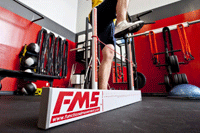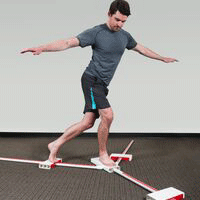The Movement and Posture Assessment looks at your body’s static posture and movement patterns whilst completing a number of dynamic tests that are part of the Functional Movement Screen (FMS) and YBalance test.
The static posture tests – look at the stresses the body is subjected to whilst in stationary functional positions we use throughout the day, particularly standing and sitting.
 The FMS (Functional Movement System) test – consists of seven test movements which challenge an individual’s ability to perform basic movement patterns that reflect combinations of muscle strength, flexibility, range of motion, coordination, balance and proprioception. The seven tests include: a deep squat, a hurdle step, rotary stability, a stability push up, an active straight leg raise, an in-line lunge, and shoulder mobility. Scores on each movement range from 0 to 3 based upon specific clinical scoring criteria.
The FMS (Functional Movement System) test – consists of seven test movements which challenge an individual’s ability to perform basic movement patterns that reflect combinations of muscle strength, flexibility, range of motion, coordination, balance and proprioception. The seven tests include: a deep squat, a hurdle step, rotary stability, a stability push up, an active straight leg raise, an in-line lunge, and shoulder mobility. Scores on each movement range from 0 to 3 based upon specific clinical scoring criteria.
Five of the seven FMS tests are scored separately for the left and right sides, and can therefore be used to locate asymmetries which have been identified as an injury risk factor.
An FMS specified cut-off value of 14 or below is suggested to indicate an elevated risk of injury. The FMS has been utilised to evaluate and reduce injury risk in specific occupational groups (e.g. firefighters), and used in professional sports teams to screen players for injury risk and to develop specific intervention and corrective exercise programs to prevent injuries.
 The Y Balance test – as an integral part of Functional Movement Systems, the Y Balance Test is a thoroughly researched, yet easy way to test a person’s motor control as well as demonstrate functional symmetry. The Y Balance Test allows us to quarter the body and look at how the core and each limb (arms and legs) function under bodyweight loads.
The Y Balance test – as an integral part of Functional Movement Systems, the Y Balance Test is a thoroughly researched, yet easy way to test a person’s motor control as well as demonstrate functional symmetry. The Y Balance Test allows us to quarter the body and look at how the core and each limb (arms and legs) function under bodyweight loads.
The Y Balance Test Protocol was developed through years of research in injury prevention and identification of muscle and motor control changes that occur after injury. This device and protocol are highly accurate and can be used for measuring pre and post rehabilitation performance, improvement after performance enhancement programs, dynamic balance for fitness programs, and return to sport readiness
Analysis and Results – From analysing each of the tests as well as your posture, we are able to an identify your body’s weaknesses and imbalances. We will then design and individualise your corrective rehabilitation program based on your weak links. If the weak link is not alleviated, the body will compensate with inefficient movement patterns. It is this type of inefficiency that can cause a decrease in performance and an increase in injuries. This individualised exercise program will involve targeted corrective exercises addressing the imbalances, or weak links, by modifying movement patterns as well as rehabilitation of specific joints and muscles. When this is accomplished you will have greater movement efficiency that will lead to improved performance and a decreased injury potential.
We will develop a personalised assessment report for you that highlights your key areas, weak links and imbalances with photographic support from your physical assessment you completed. Based on these findings documented in your assessment, your Physiotherapist will design your individualised exercise programme for you.

